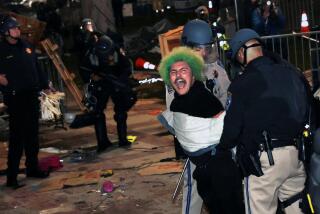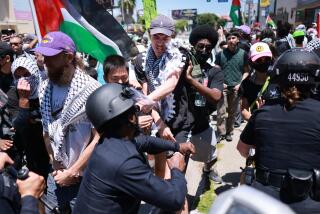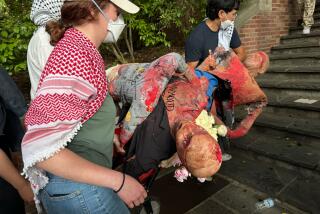Police Forcefully Break Up Melee After Concert
- Share via
While President Clinton addressed the nation Monday night from the Democratic National Convention, violence flared in the streets outside, as a few hundred protesters clashed with an extraordinarily forceful Los Angeles Police Department.
The melee broke out at the conclusion of a performance that local authorities had been dreading since it was announced. In the late afternoon, Rage Against the Machine, a loud, polemical rock band, took a concert stage to proclaim its disdain for the corruption of American democracy, across the street from the center where the president and first lady waited for their turn to address the nation.
The concert itself passed without incident, and most of the 7,000 or so people in attendance quickly departed. But just after the band finished, and as darkness was falling, a few protesters began heaving rocks, concrete and bottles over a fence at police. More peaceful demonstrators tried to restrain them, but some climbed the security fence and heaved 8-foot-high metal parking signs at police. Others set some of their signs on fire and began dancing around the flames.
Police, who were widely criticized for what was perceived as a tepid response to unruliness following the Lakers’ recent championship victory, rolled out quickly, well-armed and in overwhelming numbers.
In keeping with the LAPD’s determination to prevent any incident from gathering momentum and spreading, officers Monday night swarmed the area around the convention at the first signs of trouble. The mission, according to LAPD Cmdr. David Kalish was to “saturate the area, maintain the peace and ensure public safety.”
At a news conference at Staples Center about three hours after the violence erupted, Kalish told reporters the LAPD was in “almost a no-win situation. Some will view it as we waited too long, some will view it as moving too quickly.”
There were 10 arrests--bringing the total to 38 since protesters began assembling last weekend. There were no reports of serious injuries, and no repeat of the vandalism that damaged some businesses after the Lakers’ victory in the National Basketball Assn. championship.
There were, however, scores of people hit by rubber bullets or other projectiles. Many of those who were hit were bleeding or displayed deep, silver dollar-sized bruises.
A Times reporter who was hit on the back side of his right upper arm described an intense stinging and burning sensation at the point of impact. The rifle fire sounded like loud fireworks, sparks flew and the projectiles whizzed toward the crowd.
In the opening moments of the melee, officers tried to order the crowd out of the area near the concert.
“Down, down!” officers yelled. “Move it! Move it!”
Police Fire Into Fleeing Crowd
Confused, most of the crowd near the barricade simply crouched down, while a few others fled north on Olympic, stumbling over each other as they ran. Behind them in the dark, officers began firing rubber bullets. Glinting under the security lights, the officers’ gun barrels ejected powder plumes in the dark.
“Jesus!” Jorge Villa shouted as he stumbled, reached down to his leg, picked something up and kept running until most of the crowd was behind him. Villa, a utility meter reader who had gone to watch Rage Against the Machine, displayed a rubber police pellet. “Pretty painful,” he said, grimacing.
In addition to rubber bullets, police also used pepper spray and projectile beanbags, striking many of the protesters and some bystanders as they fired indiscriminately for more than an hour.
Ted Hayes, a homeless advocate leading a permitted march Monday evening, was struck in the chest with beanbag. He was knocked to the ground, where he gasped for breath. Hayes was taken by ambulance to nearby California Hospital, where he was in stable condition Monday night.
Nearby, an 11-year-old boy, Abraham Mejia, was with his father when he was hit by a rubber bullet. “I came to see and was just trying to get away,” Abraham said. He, like many of those hit Monday night, was struck in the back. “I am now kinda scared.”
Others who were hit by rubber bullets included American Civil Liberties Union of Southern California lawyer Carol Sobel, who helped negotiate the permit for the rally site, and Karl Manheim, a Loyola Law School professor. Most convention delegates were unaffected by the violence, but a few were caught up in it.
At one point, LAPD bicycle officers charged members of the New York delegation to push them off Figueroa Street onto the sidewalk. The New Yorkers, including New York City Public Advocate Mark Green, had been waiting for a van to take them to a party in Beverly Hills.
Shortly after the clash, the ACLU released a statement condemning the police response.
“Had the police cooperated with the rally organizers, the night could have ended calmly and smoothly,” the statement said. “Instead, the police response tonight created huge risks. When people see batons raised, riot gear and mounted police clearing an area, a tense situation becomes a volatile one.”
Kalish, the LAPD’s official spokesman, said police were forced to react to the “very violent demeanor of the crowd.”
LAPD Capt. Steward Maislin also defended the police response, saying it was provoked by unruly members of a crowd of about 1,000 who were leaving the concert.
“A dispersal order was given, which gave everybody 15 minutes to disperse,” Maislin said. “We waited in five- and 10-minute intervals, and it was actually beyond the 15-minute time limit and the crowd did not disperse.”
Several observers agreed that police had been provoked but questioned whether the level of force was necessary.
“They could have peacefully arrested the people who were causing the problem at the fence without causing a near-riot,” said Jim Lafferty, executive director of the Los Angeles office of the National Lawyers Guild.
Recent law school graduate Eric Luce and student Jennifer Calinisan were caught up in the melee. They weren’t protesters or part of any march, they said, but rather showed up because they are fans of Rage Against the Machine.
“I’ve never seen anything like this,” Luce said. “We were following orders, walking up Figueroa, then came the cavalry.”
Becky Johnson, an advocate for the homeless from Santa Cruz, said she was at a hot dog stand and was taken by surprise when the incident erupted.
“I didn’t hear any announcement or nothing,” she said. “All of a sudden people started running.”
Others said they were doing their best to obey the police but either were not given a chance or could not find a way to evacuate the area as ordered.
Pat Gowens, a protester from Milwaukee who attended a protest called the “Mothers Convention on Welfare,” said: “Between the sound of the guns and the flashes of tear gas, people were panicked. . . . We were trying to leave but they didn’t give us time. The horses were breathing on us. We literally couldn’t move because the horses were against us.”
Kelly Brand of Los Angeles said he did not have time to obey the police.
“We were dispersing and the cops rode up behind us on horses and started hitting us with batons,” he said. “One of them hit me two times. One of those times was on the back.
“Look,” Brand added, lifting his black T-shirt to show a 4-inch bloody gash on his upper back. “I’m just here to get some publicity for [American] Indian causes.”
As they tried to leave the area, some demonstrators and concert-goers were forced into the Pershing Square Red Line station. Standing in line at the ticket vending machines, the demonstrators struggled for change, anxious to get on a train.
Finally, LAPD Sgt. Steven Vinson, using a bullhorn, announced: “Everyone can ride for free as long as it’s one way.”
Oddly, the conflict Monday night came after a day in which march after march paraded through downtown with little incident. Protesters were shadowed and occasionally confronted by police, but each time conflict flared, it melted in the heat of the August afternoon.
There were dust-ups: Police arrested 10 people during an act of civil disobedience early Monday afternoon. All were booked for failure to disperse.
There was confusion: Some of the more than 260 buses chartered to shuttle delegates to Staples Center were delayed by one afternoon march. Some complained, but others chose to put the best face on it. “We’re getting into the zen [of Los Angeles],” said New York state Sen. Thomas Vuane. “There is no use complaining in California.”
There were tense moments: During one particularly critical flare-up, police aggressively charged into a group of about 1,000 demonstrators, dividing it in two and ordering both groups back to the sanctuary of Pershing Square.
For the most part, demonstrators and their police escorts seemed to take the measure of each other. Having done so, they did not always appreciate each other, but they generally decided to skip the fight--at least for the day.
One incident Monday morning helped set the tone for the early part of the day.
During a morning march that snaked between downtown high-rises, a group of about 50 black-clad anarchists chanting anti-police slogans broke off from the rest of a demonstration and locked arms, shoving aside photographers and others.
“No justice, no peace, no racist police,” they chanted.
About 200 officers, helmets on, face shields down, deliberately and ominously advanced toward the band of protesters.
“What are we going to do?” one protester shouted as others tried frantically to organize. Just before the two sides clashed, however, the anarchist group disbanded, melting back into the parade. Police withdrew without using force or making arrests.
Marchers Block Intersection
Indeed, arrests were few and far between on Monday.
The largest block of them occurred just after noon, when a group of protesters on one of the day’s many marches broke off from the main body of the demonstration and sat down in an intersection. The act of civil disobedience was intended to call attention to their charge that Occidental Petroleum’s plans to drill in an area of Colombia threatened the ancestral home of a indigenous tribe called the U’wa.
As the demonstrators sat down, many other marchers turned to watch. For a few moments, the sit-down appeared to unfold quietly. One person brought food and water to the protesters in the intersection, and police prepared to make arrests.
Then, according to witnesses, a man with a sign bumped into an officer.
Police responded quickly and forcefully, splitting the crowd in half and pushing it back toward Pershing Square. One of the police lines broke into a run, charging into the other group of demonstrators and forcing them back as well.
The area suddenly was pierced by screams. The smell of vinegar, which protesters use to cut through tear gas, hung strongly in the air. But the tension subsided after a few minutes, as most demonstrators straggled back to the square and police returned to their wary vantage points at its periphery.
Protesters loudly complained later that LAPD officers had overreacted.
“We knew they were going to come on strong, that they were going to try to scare us away,” said Susan Goldberg, 26, of Echo Park. “But they are not going to scare us by using these brute scare tactics.”
Goldberg also said the police attacked protesters without provocation.
“It was just a gross and exaggerated use of force and was completely unnecessary for what was happening,” she said.
Deputy Chief Maurice Moore, who walked with teams of officers throughout the day, said he believed officers were being provoked by some demonstrators. Overall, however, he thought the day was relatively peaceful.
“Our intelligence tells us there are those here who want to incite some kind of violence,” Moore said, standing across the street from Pershing Square. “They all have cameras and videos. They are waiting for us to do something they perceive as negative and they can use it in civil court.”
*
This article was written by Times staff writer Jim Newton.
More to Read
Get the L.A. Times Politics newsletter
Deeply reported insights into legislation, politics and policy from Sacramento, Washington and beyond. In your inbox three times per week.
You may occasionally receive promotional content from the Los Angeles Times.











